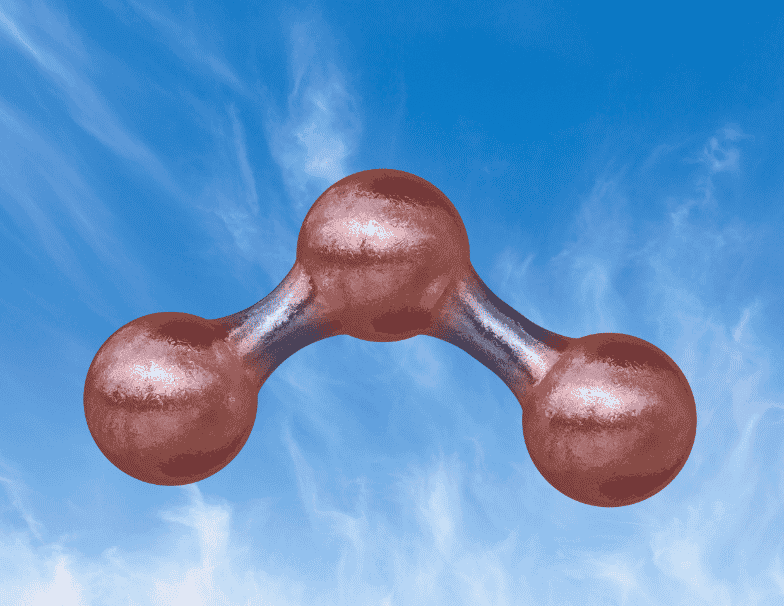Ozone disinfection is a type of cleaning that uses ozone to sanitise the environment.
Ozone is a very powerful disinfectant that not only attacks the protective layer of bacteria, but also manages to eliminate the molecules and germs that cause bad odours, making it an effective and fast disinfectant that does not damage surfaces.
In this article we tell you what ozone disinfection of air and surfaces consists of, as well as its pros and cons.
What is ozone?
Ozone is a molecule made up of three oxygen atoms.
Two oxygen atoms form the basic oxygen molecule, which we breathe and which is essential for life. In the case of ozone, the third oxygen atom can break away from the ozone molecule and rejoin the molecules of other substances, thus altering their chemical composition. This ability to react with other substances is the basis of ozone cleaning.
What is ozone cleaning?
Ozone disinfection is a method of sterilising surfaces and micro-particles floating in the air. So it eliminates mould spores, fungi, dust mites, viruses, bacteria and even bed bugs.
In many establishments and premises, ozone disinfection of COVID-19 became very common during the pandemic.
However, ozone cleaning requires an ozonator, i.e. an ozone generator. It can be used both in gaseous and liquid form to purify air and surfaces.
How does ozone disinfection work?
When ozone generators release ozone gas (O3) into an enclosed space, and the gas reaches a specific concentration during a specific exposure period, ozone kills bacteria, mould spores and fungi. In the same way, it also damages the cell wall and protein spikes of viruses, disinfecting the air and virtually any surface. Be it objects, equipment or, most importantly, any micro-particles floating in the environment, as well as those inside air ducts and filters.
During the ozone disinfection cycle, the gas rapidly fills the enclosed area and the third atomic particle attaches itself to bacteria, mould, fungi, viruses and other organic matter on surfaces, objects, fabrics or microparticles floating in the air.
The oxidation process then removes the third oxygen atom that exists in ozone (O3) and microorganisms. What is left is therefore a totally disinfected area where the only residue is fresh, clean oxygen (O2), since the microorganisms that produce bad odours have also been destroyed. This is undoubtedly an innovative and effective solution.
Ozone and health
Ozone is used when no people are present. Why?
Ozone decontaminates a space from chemical, biological pollutants and odours. However, the place must always be unoccupied.
As we have seen in the previous point, the same chemical properties that allow high concentrations of ozone to react with organic matter, also give it the ability to react with the organic matter that makes up our body, causing detrimental health effects.
When inhaled, ozone can cause lung damage. Even relatively low amounts can cause chest pain, coughing, shortness of breath and throat irritation.
For this reason and because of its toxicity, despite its efficiency, catalytic filters have been developed for the removal of residual ozone.
Applications of ozone disinfection
Ozone disinfection is generally used in medium and large plants. However, after the pandemic and due to its proven effectiveness, its use as a surface and air disinfectant has been extended to a large number of businesses and premises.
Likewise, ozone air cleaning effectively eliminates bad smells without leaving any odorous residue in the environment, thanks to its high oxidising power, it is capable of completely eliminating the organic compounds that cause bad smells on any surface. For this reason, it is often used to clean the air and walls after a fire has been extinguished.
On the other hand, the use of ozone for disinfection, treatment and purification of water has been widely used for a long time. Similarly, ways of disinfecting plants and crops in the agricultural industry have been developed using ozone water treatment.
Advantages and disadvantages of ozone disinfection
Advantages
- Ozone is more effective than chlorine in destroying viruses and bacteria.
- The ozonisation process requires little time (between 10 and 30 minutes).
- Virtually no harmful residues remain to be removed after ozone disinfection.
- It decomposes quickly.
- After cleaning with ozone, there is no reoccurrence of microorganisms.
- Ozone disinfection is generated in situ and therefore, there are no safety problems related to transport and handling.
Disadvantages
- Low ozone concentration may not effectively remove some viruses, spores and micro-organisms.
- Ozonation uses a more complex technology than chlorine or UV disinfection.
- Ozone is reactive and corrosive, so it must be applied to corrosion resistant materials.
- Contact with ozone is extremely irritating and toxic to humans.
Are you looking for an effective disinfection system to improve your products or processes? At INFINITIA we are experts in developing new and effective solutions for our customers. Contact our materials innovation team and tell us about your case.





